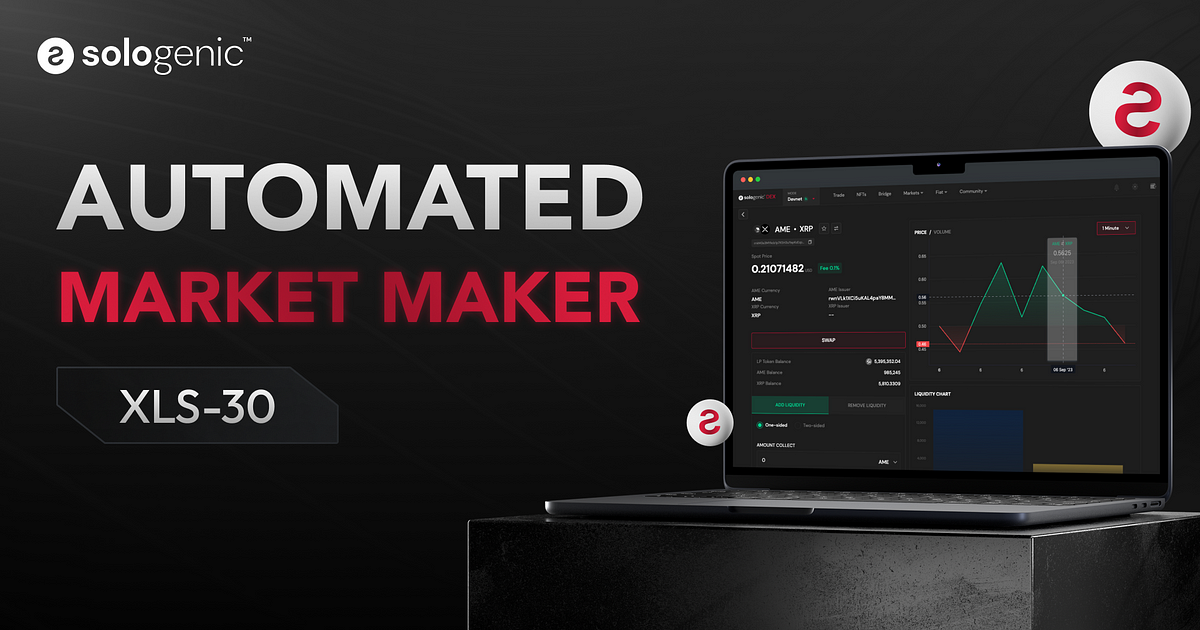XLS-30: A Quantum Leap Into DeFi for Sologenic and the XRPL Ecosystem
Being one of the earliest blockchains in the industry, the XRP Ledger has been a cornerstone for innovation. Through its decentralized exchange (DEX), it has democratized access to financial markets. However, having an organic order book exchange, the ledger faces challenges in liquidity provision, relying on traditional market makers and order books.
The XLS-30 proposal, Ripple’s seminal Automated Market Maker (AMM) technology, aims to change that and the Sologenic Development Foundation is at the edge of its development, aiming to launch as soon as the proposal is approved. Having an AMM protocol that’s native to the XRP Ledger is not just an incremental improvement; it’s a quantum leap that aligns deeply with the foundation’s mission to make financial markets more accessible, efficient, and secure for everyone.
Streamlined Liquidity Through AMM Instances
An AMM instance acts as a self-sustaining liquidity pool that automates the buying and selling of assets. This eliminates the need for manual market makers, thereby simplifying the entire process of liquidity management.
In this context, one of the standout features of the XLS-30D proposal is the creation of more concentrated and efficient asset pools through AMM instances. In traditional systems, liquidity can be fragmented across multiple market makers and trading pairs, reducing efficiency and increasing costs. The XLS-30 proposal addresses this by allowing for the creation of a single AMM instance per unique asset pair. This concentration of liquidity ensures that assets can be traded more smoothly and at better prices.
Another stand-out feature is the flexibility in how assets can be deposited or withdrawn. Users have the option to make “equal-asset” deposits, meaning they can contribute an equal value of both assets in the trading pair to the liquidity pool. Alternatively, they can opt for “single-sided” deposits, where they contribute only one of the assets. This flexibility extends to withdrawals as well, allowing users to remove their assets in a manner that aligns with their investment strategy.
Cost-Effective and Flexible Trading on Sologenic
The Sologenic DEX was launched in 2019 with the aim of providing a user-friendly interface for users to interact with the native XRPL DEX. The new AMM protocol reinforces this premise while making the ecosystem more cost-effective and streamlined. With automated market making, the spread between buying and selling prices is often narrower, resulting in better rates for traders and investors.
Moreover, the flexibility in deposit and withdrawal options also lowers the entry barrier for new and casual investors. Users can start small with single-sided deposits and gradually diversify their portfolio as they become more comfortable and experienced, making the Sologenic ecosystem more accessible to a broader range of participants.
Community-Driven Fee Structure
A hallmark of the XLS-30 proposal is its empowerment of liquidity providers, specifically LP Token holders, by granting them the authority to vote on the trading fee structure. This democratizes the decision-making process, ensuring that those deeply invested in the ecosystem can shape its operational dynamics.
Coupled with an innovative auction system, the proposal promotes equitable profit distribution between liquidity providers and those capitalizing on market price variances. This dual approach not only incentivizes liquidity provision but also guarantees a more balanced profit-sharing mechanism for all stakeholders.
The Future of the XRPL Ecosystem
The introduction of AMM instances through the XLS-30 proposal represents a significant advancement in liquidity management. By creating concentrated and efficient asset pools, the system ensures smoother, faster, and more cost-effective transactions. For Sologenic, it aligns perfectly with the foundation’s mission to make financial markets more accessible and efficient for everyone, from retail investors to large institutions.
About Sologenic.org
Sologenic is the leading ecosystem on the XRP Ledger, offering a suite of decentralized applications, streamlining digital asset management while merging traditional finance and Web3 infrastructure. It offers an organic order book DEX, a Market Index devised for tracking all major XRPL tokens, an IDO Launchpad, an NFT Marketplace, and an upcoming on-demand asset tokenization platform.
About Sologenic.com
Sologenic’s regulated arm is deploying a platform with a hybrid model for the on-demand tokenization of assets. The Sologenic Asset Tokenization Platform facilitates trading between crypto and off-chain traditional assets such as stocks & ETFs. This technology is also available through SoloNex, an institutional-grade offering designed for RIA’s, brokerage houses, family offices, banks and other financial institutions looking to tokenize real-world assets for their clients.
https://sologenic.medium.com/xls-30-a-quantum-leap-into-defi-for-sologenic-and-the-xrpl-ecosystem-1686cf477429





























